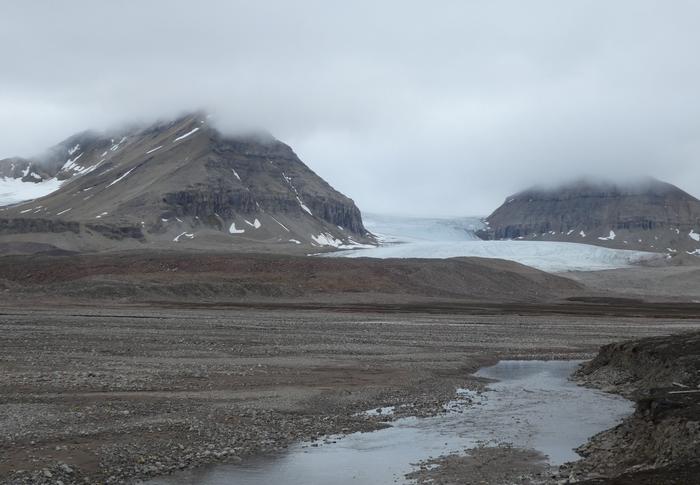Researchers from Nagoya University and the National Institute of Polar Research in Japan have found that dust from land without snow cover in the Arctic is a major source of particles that form ice crystals in low-level clouds of the Arctic (at altitudes below about 3 km) during summer and fall.

Credit: Yutaka Tobo, National Institute of Polar Research
Researchers from Nagoya University and the National Institute of Polar Research in Japan have found that dust from land without snow cover in the Arctic is a major source of particles that form ice crystals in low-level clouds of the Arctic (at altitudes below about 3 km) during summer and fall.
The formation of ice crystals in low-level clouds is considered to affect climate because it can cause ice particles to grow at the expense of liquid droplets and then fall as precipitation, resulting in a lower sunlight reflectance and a shorter lifetime for clouds.
“The Arctic is said to be heating up two to four times faster than the rate of global warming,” said Dr. Kei Kawai of Nagoya University, the first author of the study. “Considering that the distribution and the lifetime of low-level clouds affect climate, our finding might help improve predictions of Arctic climate change.” The researchers published their findings in Geophysical Research Letters.
Dust is made up of very small mineral particles of earth or sand. It acts as a nucleus for the formation of ice crystals in clouds. Although mainly emitted from arid regions in low or mid latitudes, recent studies have shown that dust is also emitted from areas where there is no snow, ice, or vegetation in the Arctic. A previous study suggested that such Arctic dust serves as an efficient nucleus for forming ice crystals because it contains a tiny amount of organic matter that has high ice nucleating ability.
“In the Arctic, dust is mostly emitted in summer through early fall, when the surface temperature is high and the snow cover is low,” Kawai said. “In this season, Arctic dust is distributed in the lower troposphere of the Arctic (lower than an altitude of approximately 3 km), where temperatures are warmer than about –15°C. In general, dust particles from a desert in low or mid latitudes cannot work efficiently as nuclei to form ice crystals at temperatures warmer than –15°C. In contrast, Arctic dust particles can work as such nuclei between –20°C and –5°C because of their high ice nucleating ability.”
However, until now, the importance of Arctic dust’s high ice nucleating ability has remained unclear because it was not considered in any modeling studies. To address this shortcoming, Associate Professor Hitoshi Matsui and Dr. Kawai of Nagoya University, in collaboration with Associate Professor Yutaka Tobo of the National Institute of Polar Research, conducted a study using the global aerosol-climate model CAM-ATRAS.
First, they incorporated the recently observed high ice nucleating ability of Arctic dust into their model. Then, they compared simulations that considered this ability with simulations that did not. The results showed that in simulations that considered this ability, Arctic dust acted efficiently as ice nucleating particles in the Arctic region. The simulations also closely reproduced observations of ice nucleating particles at several locations in the Arctic. In contrast, in simulations that did not consider it, Arctic dust hardly acted as ice nucleating particles.
The results also showed that the number of ice nucleating particles from dust from all around the world in the lower troposphere of the Arctic during summer and fall was increased by more than 100 times considering the high ice nucleating ability of Arctic dust. Furthermore, almost all the ice nucleating particles were found to be derived from Arctic dust.
Therefore, the researchers confirmed that Arctic dust plays a dominant role as ice nucleating particles from dust in Arctic low-level clouds during summer and fall. “We demonstrated that it is important to fully consider Arctic dust’s high ice nucleating ability to clarify the distribution and the origin of ice nucleating particles in the Arctic,” Dr. Kawai said. “We hope this finding will also help us understand what is happening regarding Arctic warming and more accurately project future Arctic climate change.”
Journal
Geophysical Research Letters
DOI
10.1029/2022GL102470
Method of Research
Computational simulation/modeling
Subject of Research
Not applicable
Article Title
Dominant Role of Arctic Dust With High Ice Nucleating Ability in the Arctic Lower Troposphere
Article Publication Date
25-Apr-2023




